In the first article in this dingo diet series, we covered what to feed your adopted dingo, including what dingoes can eat daily, weekly and ways to enhance their diet. Next, we look at frequently asked questions about dingo diets.
This series has been produced with thanks to Canine Ascension — thank you for generously sharing knowledge and reviewing this article.
Table of contents
- Can I feed my dingo dried meat?
- Which bones can my dingo eat?
- Which types of fish can I feed my dingo?
- What kind of mussels can I feed my dingo?
- Which organs can I feed my dingo?
- How do I prepare wild game for my dingo?
- What kind of fermented vegetables can I give my dingo?
- Can dingoes consume coconut oil?
- Which kibble or dried food can I feed by dingo?
- What can I use for dingo training treats?
1. Can I feed my dingo dried meat?
Yes — stick to the meat types listed in Dingo Diet Part 1. If the meat is packaged, check the ingredients to avoid unnecessary ingredients, excess fat and starchy carbohydrates.
2. Which bones can my dingo eat?
- Raw, digestible bones e.g. from poultry or rabbit
- Ribs and tails from other animals might be suitable (except beef)
Bones to avoid:
- Beef ribs
- Cooked bones — these can splinter and cause significant injury
- Do not feed your dingo weight bearing bones from large animals
Note that larger bones can be given for enrichment/recreation, but not consumed. For example, large kangaroo tails, beef necks.
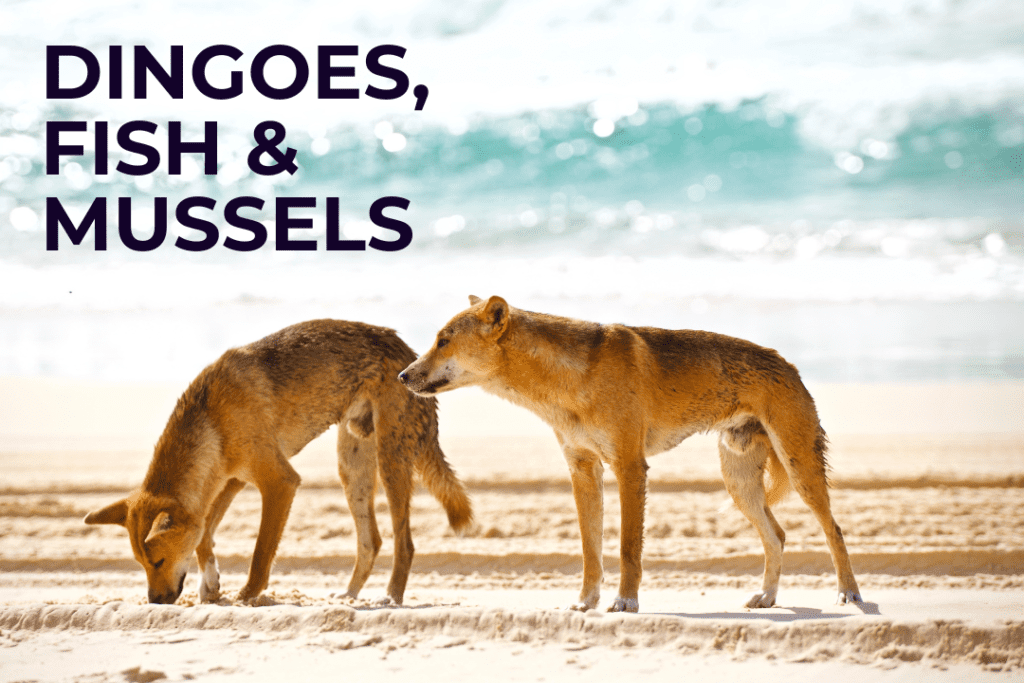
3. Which types of fish can I feed my dingo?
- Feed your dingo fish 1-4 times a week. See this post for more info
- Consider oily fish such as sardines, mackerel or salmon
- Fresh, whole fish is best
- Fish canned in springwater is also a great option
- If using canned fish, discard the water and rinse before feeding.
Which fish to avoid:
- High mercury fish such as tuna, snapper, tilapia, haddock
- Smoked or cured fish
- Cooked whole fish
- Fish canned in olive oil or sauce (too much sodium)
Click here to read the benefits of fish for your dingo
4. What kind of mussels can I feed my dingo?
- Feed 1-2 per meal, 2-4 times a week
- Blue mussels, mud mussels or green lipped mussels
How should mussels be prepared for my dingo?
- The easiest options are canned mussels or pre-steamed frozen mussels
- Opt for canned mussels in springwater with less than 100mg of sodium
- Pre-steamed, frozen mussels are ready for consumption, just defrost and remove the shells first.
- Fresh, raw mussels must be lightly steamed for safety reasons
Another option is to use green lipped mussel powder, such as Healthy Care or Blackmore’s. The dose mentioned by Canine Ascension is 30mg of powdered extract per kilo of body weight, but always seek professional advice before feeding your dingo supplements.
What if your dingo doesn’t like mussels? Click here for more options.
5. Which organs can I feed my dingo?
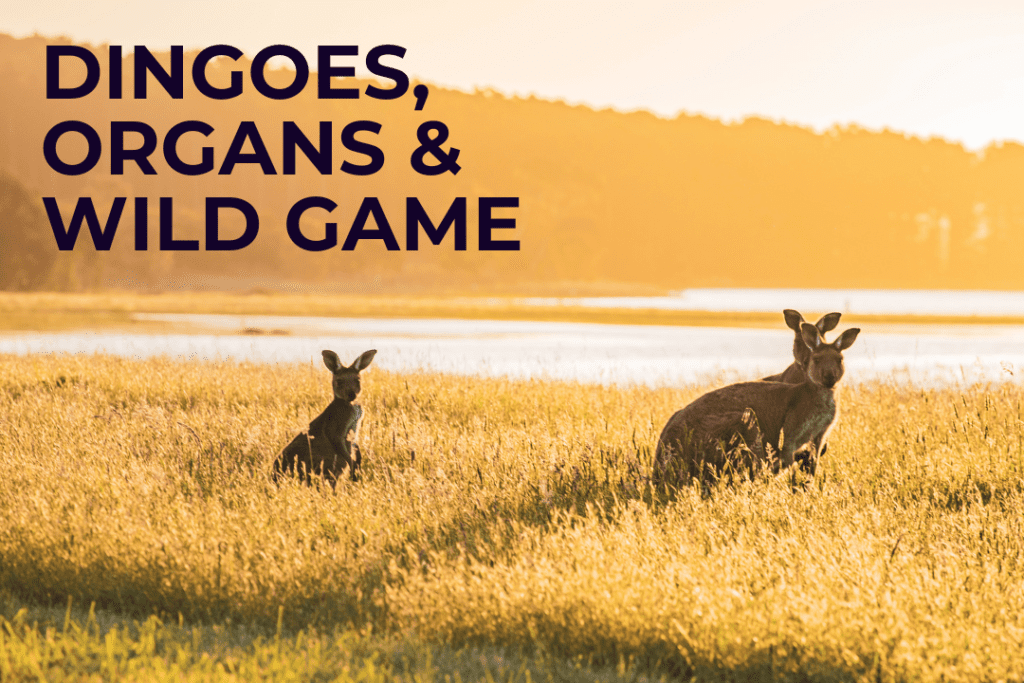
- Rotate between different organs from different animals such as kangaroo, beef, lamb, goat and chicken.
- Liver should make up 5% of a dingo’s daily diet.
- Non-secreting organs including heart, lungs, giblets, trachea should be counted as meat in your dingo’s daily food ratio.
- Secreting organs should make up 5% of your dingoes diet, including kidneys, pancreas, brain, spleen.
Avoid:
- Do not feed intestines to your dingo.
How to prepare organs for your dingo:
- Feed supermarket organ meats fresh.
- Trim all fat from beef hearts and only feed to your dingo in moderation, no more than 10% of the total muscle meat ratio.
- Organ meats from wild game should be checked for parasites, then frozen for 3 weeks at -19 to -20 degrees celsius.
More information about feeding organs to your dingo:
- Why, what and where to source (Canine Ascension)
- How to deal with organ meat refusal (Canine Ascension)
6. How do I prepare wild game for my dingo?
Wild game refers to animals which have been hunted, rather than farmed, for example wild kangaroo, deer or rabbits.
Canine Ascension states that, “Wild game should be frozen for 3 weeks at -18°C or lower to kill potential parasites.”
7. What kind of fermented vegetables can I give my dingo? Can I use store-bought fermented vegetables? What about other fermented foods?
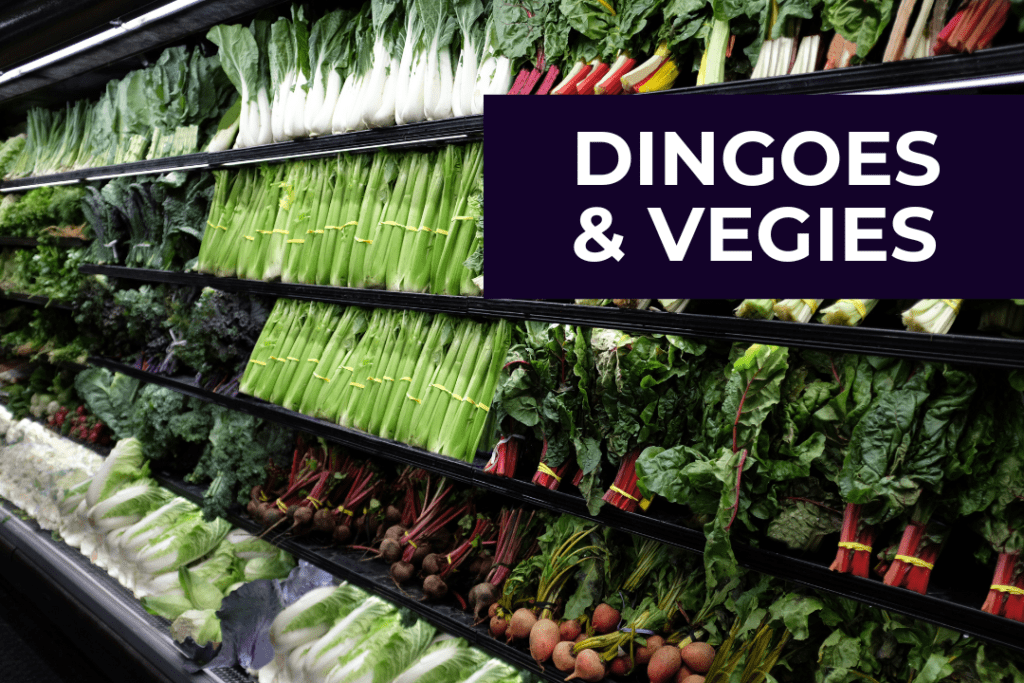
Feed your dingo limited amounts of:
- fermented greens such as cabbage (sauerkraut)
- fermented cottage cheese, cultured raw butter
- fermented pumpkin seeds
Canine Ascension recommends fermenting these foods at home, rather than buying products which are already fermented, to keep the salt and additives low. Introduce fermented foods gradually. Here is a recipe by Canine Ascension.
Avoid:
- Store bought fermented foods, these have too much salt
- High GI and starchy vegetables such as potatoes, pumpkin, sweet potatoes, beetroot, carrots, pumpkin, parsnips and turnips
- Do not include extra flavours such as onions, olives, chilli, jalapeno peppers.
8. Can dingoes consume coconut oil?
Yes, in limited quantities. Coconut oil can improve your dingo’s skin, coat, teeth and overall health. Whilst we avoid farmed animal fat in dingo diets, some fat is necessary.
- Use organic, unrefined, virgin/cold pressed coconut oil
- ½ to 1 tsp per serve
- Add coconut oil to your dingo’s diet 1-4 times per week
- 1-2 times per week for a dingo who mostly eats poultry and/or beef
- 3-4 times per week if your dingo primarily eats wild game meat
Winter and autumn are good times to include coconut oil, as well as before intense exercise, during pregnancy and lactation and during your dingo’s senior years.
Canine Ascension notes that coconut oil should be avoided if your dingo has diabetes or liver disease.
9. Which kibble or dried food can I feed by dingo?
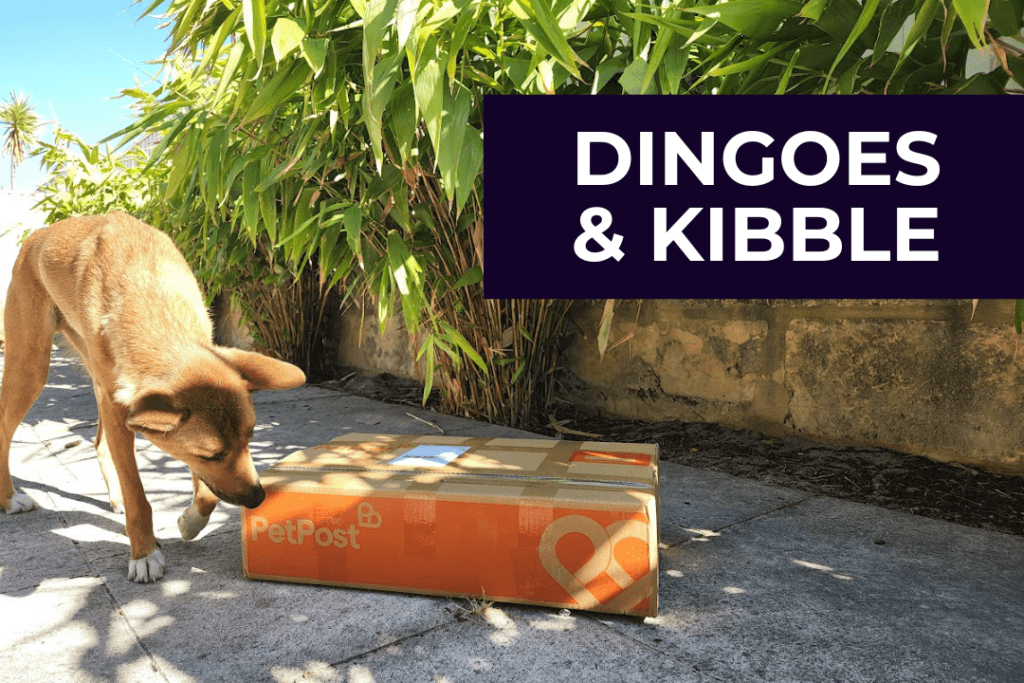
Dingoes thrive on a raw meat diet. In most cases, commercial kibble includes a high percentage of starchy carbohydrates, which does not align well with the nutritional needs and biology of Australian dingoes. Canine Ascension states that “Australian dingoes lack the gene coding for digesting starch.”
If necessary, kibble can be used to supplement your dingo’s diet but kibble should not be their main source of nutrition. Canine Ascension states that “Dingoes fed high fat, high carb diets have around half the life expectancy of a dingo fed a species-appropriate diet. They may also be more prone to bouts of pancreatitis and liver complications.” Click here to read more about dingoes, pancreatic amylase and starchy carbohydrates.
What to avoid when choosing kibble for your dingo:
- Avoid grains such as rice and flour.
- Avoid starchy vegetables such as potato, sweet potato, pumpkin and carrots, which are very common in commercial dog foods.
If you choose to feed your dingo kibble, Canine Ascension recommends using the National Research Council’s equation for calculating the total soluble carbohydrate content in a bag of kibble.
Equation:
- Go to the guaranteed analysis panel, and add together Protein + Fat + Moisture + Ash, minus from 100 = soluble carb percentage total in product.
- If moisture isn’t listed use the NRC average 10.
- If ash isn’t listed use 6.
Why are grain-free kibbles so much higher in starch? This is because in place of grains, pet feed companies use legumes and pulses in their place:
- Lentils 385g of starch per kilo
- Oats 400g of starch per kilo
- Peas 410g of starch per kilo
- Chickpeas 435g of starch per kilo
- Potatoes 650g of starch per kilo
- Corn 728g of starch per kilo
- Rice 810g of starch per kilo
We feed our dingoes kibble very sparingly, using small amounts in enrichment toys like Kongs and Likimats.
10. What can I use for dingo training treats?

High value food such as raw meat may be useful in some situations, however may be impractical from a food safety perspective.
When raw meat is not suitable, consider using dried kangaroo, chicken, fish, beef or shark. Online pet stores, local pet stores and discount stores offer dried meat for dogs, just be sure to check the ingredient list — the best types are 100% animal, with no additives or preservatives.
Suitable brands include Australian brands: Lulu’s Kitchen, Fit’n’Flash and Black Dog as well as Ziwi Peak (NZ) and Absolute Holistic (USA).
Small dingo-friendly treats:
- Queenfish Bites $28 for 200g from Rover Pet Products ($140/kg) (Recommended by Canine Ascension)
- Lulu’s Kitchen Baby Got Mack Mackerel Bites $18.95 for 100g from Rover Pet Products ($189.50/kg)
- Ziwi Peak Daily Dog Cuisine Chicken Dry Dog Food $49.98 for 454g from Pet Stock ($110/kg)
- Ziwi Peak Air Dried Venison Recipe Dry Dog Food $53.99 for 454g from Pet Circle ($118.92/kg)
- Absolute Holistic Air Dried Beef and Venison $59.99 for 1kg from Pet Circle ($59.99/kg)
- Absolute Holistic also offers Air Dried Chicken and Hoki and Beef and Hoki
- Love-em Air Dried Beef Liver $11.20 for 200g from Coles ($56/kg) These can be easily broken into smaller pieces.
- Lickables Roo Bites $10.99 for 100g from Pet Stock ($109.90/kg)
Larger dingo-friendly treats:
- LuLu’s Kitchen Shark Cartilage $17.95 for 100g from Rover Pet Products ($179.5/kg) (Recommended by Canine Ascension)
- LuLu’s Kitchen Gettn’ Lippy Wit It Green Lipped Mussels $22.95 for 80g from Rover Pet Products ($286.88/kg)
- Coles Red Ribbon Liver Pieces $4 for 100g from Coles ($40/kg)
- WAG Chicken Breast Dog Treats $20.98 for 200g from Pet Stock ($104.90/kg)
- Black Dog Roo Liver $10.98 for 100g from Pet Stock ($109.80/kg)
- Black Dog Roo Jerky $9.49 for 80g from Pet Stock $118.63/kg)
- Black Dog Beef Liver $11.49 for 150g from Pet Circle ($76.60/kg)
- Fit’n’Flash Kangaroo Chews $12.99 for 60g from Pet Stock ($216.50/kg)
- Many Fit’n’Flash treats are suitable for dingoes, as they have no additives. View the full Fit’n’Flash range here. They also only use Australian ingredients!
Canine Ascension also offers a recipe for Tori’s Training Treats, made primarily of kangaroo mince and eggs.
>>> Next: Dingo diet: sourcing and preparing your dingo’s dinner.
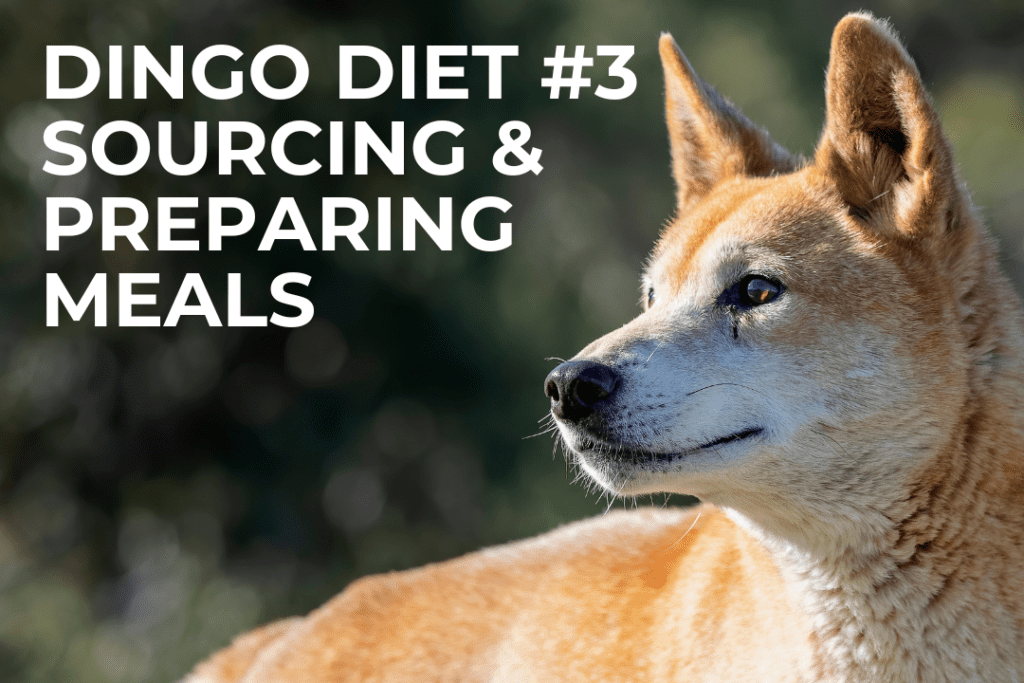
NOTE: Prices accurate as of 15 August 2024.
NOTE: This article is general in nature and is for information purposes only. It is not a substitute for specific qualified advice that considers your or your dingo’s specific circumstances.
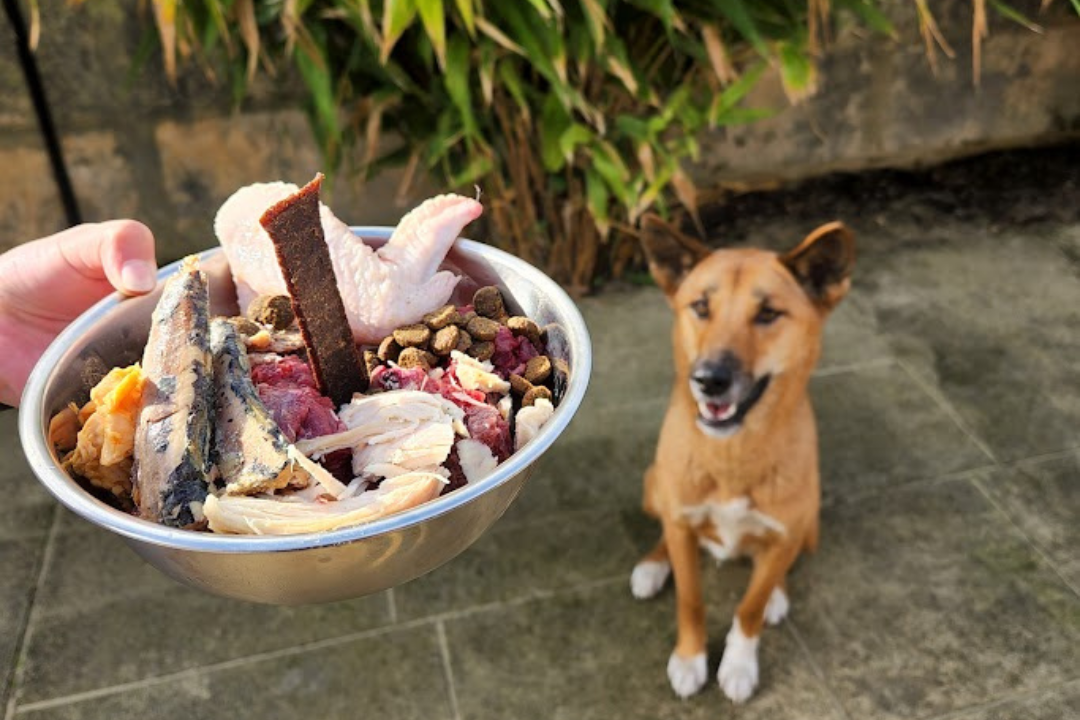
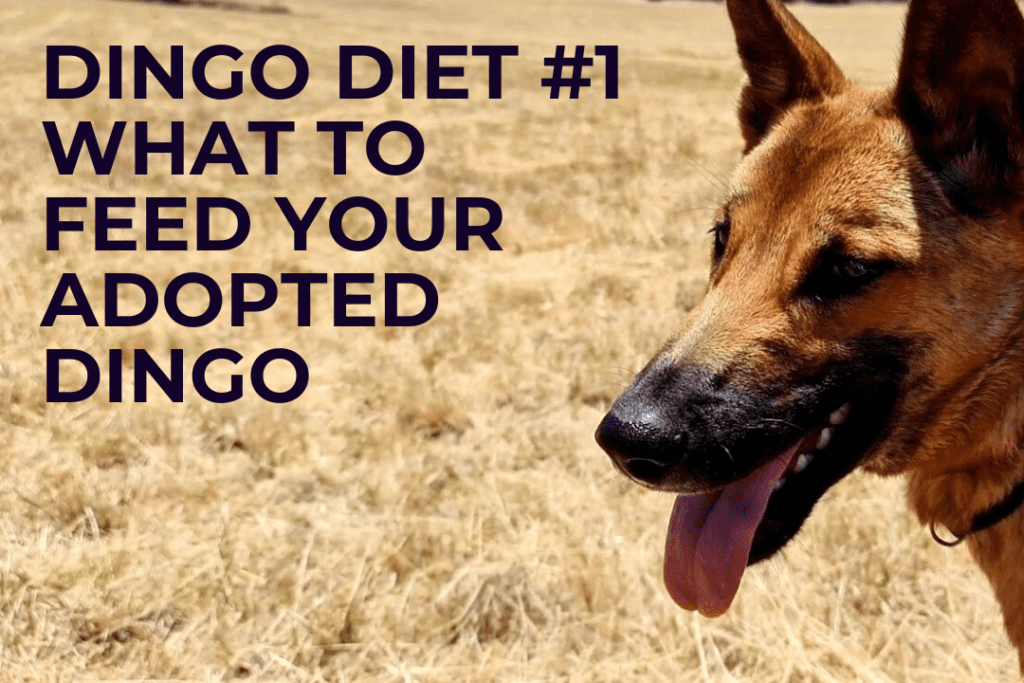
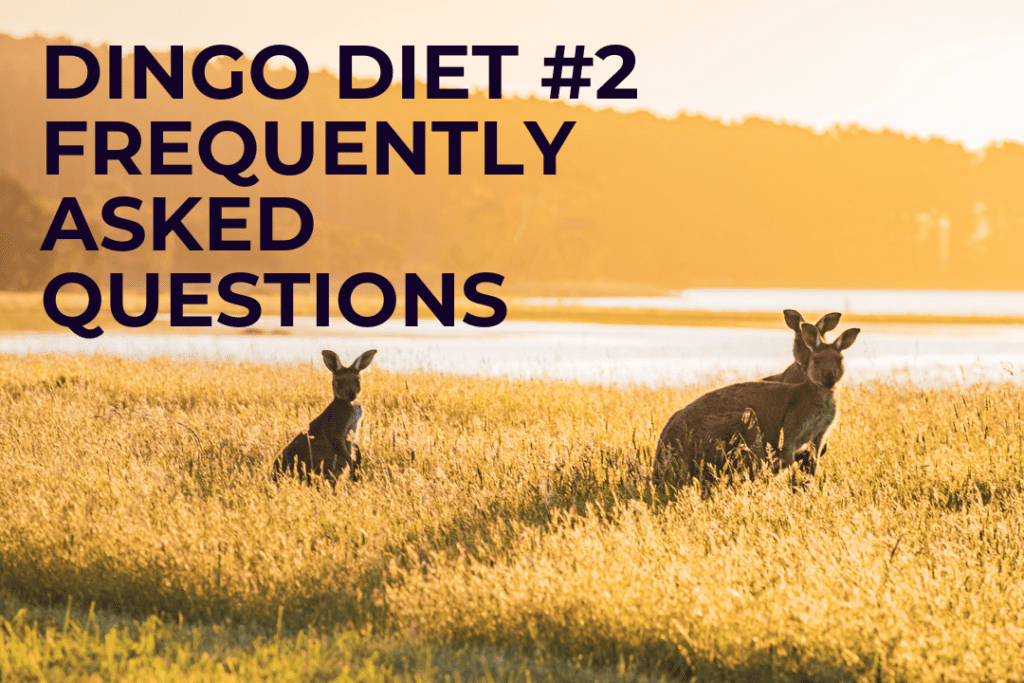
0 Comments